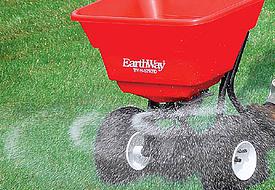Fertilizer Treatment

Fertilizer is an important lawn care practice, as it influences grass color, ability to recover from stress and helps prevent weed invasions and diseases.
There are a variety of fertilizer applications. With the exception of “Weed and Feed”, it is best to apply them just before a rainfall, as they need to be watered in. Fertilizers with weed killers need to sit on the lawn for a day or two, to allow the weed killer to do its task, and then it should be watered. Never apply “Weed and Feed” just before rain is expected, as you are only harming the environment.
How often you apply fertilizer also depends upon the area and climate you live in. The most common is four applications. For lawns, fertilizers containing controlled-release nitrogen sources are suggested for most applications, because they help assure uniform growth and do not readily burn grass. We strictly use organic treatments and manual techniques to ensure the highest success rate.
Four (4) Liquid Applications Of Fertilizer With Injected Weed Control
(Watering required by customer; applied in droplet form using dual hoses to inject weed control into fertilizer mix wherever weeds are present. We do NOT mist spray.)
• Liquid fertilizer contains 14% Nitrogen (N), 2% Phosphorus (P) and 5% Potassium (K).
• Weed Control is a post-emergent product (i.e. weeds must already be present) called Par III, which is similar to Killex and contains the following active ingredients: Mecaprop, Dicamba, and trace amounts of 2, 4-D amine.
• The following are your liquid fertilizer applications: Round 1 (Spring starter), Round 2 (Intensifier), Round 3 (Summer Beautifier), Round 4 (Early Fall).
One (1) Granular Application Of Fertilizer
(No watering required; applied using a spreader)
• Granular fertilizer contains 22% Nitrogen, 0% Phosphorus, 30% Potassium.
• The granular service is called Round 5 (Winterizer)
